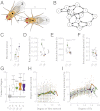Social structures depend on innate determinants and chemosensory processing in Drosophila
- PMID: 22802679
- PMCID: PMC3477376
- DOI: 10.1073/pnas.1121252109
Social structures depend on innate determinants and chemosensory processing in Drosophila
Abstract
Flies display transient social interactions in groups. However, whether fly-fly interactions are stochastic or structured remains unknown. We hypothesized that groups of flies exhibit patterns of social dynamics that would manifest as nonrandom social interaction networks. To test this, we applied a machine vision system to track the position and orientation of flies in an arena and designed a classifier to detect interactions between pairs of flies. We show that the vinegar fly, Drosophila melanogaster, forms nonrandom social interaction networks, distinct from virtual network controls (constructed from the intersections of individual locomotor trajectories). In addition, the formation of interaction networks depends on chemosensory cues. Gustatory mutants form networks that cannot be distinguished from their virtual network controls. Olfactory mutants form networks that are greatly disrupted compared with control flies. Different wild-type strains form social interaction networks with quantitatively different properties, suggesting that the genes that influence this network phenotype vary across and within wild-type populations. We have established a paradigm for studying social behaviors at a group level in Drosophila and expect that a genetic dissection of this phenomenon will identify conserved molecular mechanisms of social organization in other species.
Conflict of interest statement
The authors declare no conflict of interest.
Figures




Similar articles
-
The Gene CG6767 Affects Olfactory Behavior in Drosophila melanogaster.Behav Genet. 2019 May;49(3):317-326. doi: 10.1007/s10519-019-09949-8. Epub 2019 Feb 1. Behav Genet. 2019. PMID: 30710192
-
The Drosophila melanogaster foraging gene affects social networks.J Neurogenet. 2021 Sep;35(3):249-261. doi: 10.1080/01677063.2021.1936517. Epub 2021 Jun 12. J Neurogenet. 2021. PMID: 34121597
-
High-throughput ethomics in large groups of Drosophila.Nat Methods. 2009 Jun;6(6):451-7. doi: 10.1038/nmeth.1328. Epub 2009 May 3. Nat Methods. 2009. PMID: 19412169 Free PMC article.
-
Taste and pheromone perception in the fruit fly Drosophila melanogaster.Pflugers Arch. 2007 Aug;454(5):735-47. doi: 10.1007/s00424-007-0246-y. Epub 2007 May 1. Pflugers Arch. 2007. PMID: 17473934 Review.
-
Pheromone perception and behavior in Drosophila.Curr Opin Neurobiol. 2004 Aug;14(4):435-42. doi: 10.1016/j.conb.2004.07.008. Curr Opin Neurobiol. 2004. PMID: 15321064 Review.
Cited by
-
Larval Population Density Alters Adult Sleep in Wild-Type Drosophila melanogaster but Not in Amnesiac Mutant Flies.Brain Sci. 2014 Aug 11;4(3):453-70. doi: 10.3390/brainsci4030453. Brain Sci. 2014. PMID: 25116571 Free PMC article.
-
Mechanosensory interactions drive collective behaviour in Drosophila.Nature. 2015 Mar 12;519(7542):233-6. doi: 10.1038/nature14024. Epub 2014 Dec 24. Nature. 2015. PMID: 25533959 Free PMC article.
-
Movement and Dispersion Parameters Characterizing the Group Behavior of Drosophila melanogaster in Micro-Areas of an Observation Arena.Animals (Basel). 2025 May 22;15(11):1515. doi: 10.3390/ani15111515. Animals (Basel). 2025. PMID: 40508981 Free PMC article.
-
Ecology of information: social transmission dynamics within groups of non-social insects.Proc Biol Sci. 2015 Feb 22;282(1801):20142480. doi: 10.1098/rspb.2014.2480. Proc Biol Sci. 2015. PMID: 25589603 Free PMC article.
-
Attraction to and learning from social cues in fruitfly larvae.Proc Biol Sci. 2013 Jul 31;280(1767):20131398. doi: 10.1098/rspb.2013.1398. Print 2013 Sep 22. Proc Biol Sci. 2013. PMID: 23902906 Free PMC article.
References
-
- Shorrocks B. Drosophila. London: Ginn; 1972.
-
- Sokolowski MB. Social interactions in “simple” model systems. Neuron. 2010;65:780–794. - PubMed
-
- Wertheim B, van Baalen EJ, Dicke M, Vet LE. Pheromone-mediated aggregation in nonsocial arthropods: An evolutionary ecological perspective. Annu Rev Entomol. 2005;50:321–346. - PubMed
-
- Mery F, et al. Public versus personal information for mate copying in an invertebrate. Curr Biol. 2009;19:730–734. - PubMed
Publication types
MeSH terms
Grants and funding
LinkOut - more resources
Full Text Sources
Molecular Biology Databases

